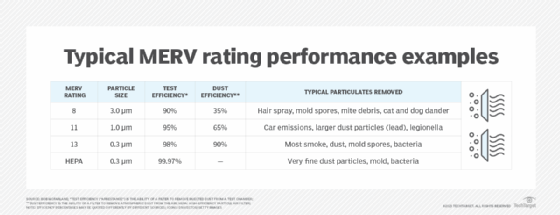
Getty Images/iStockphoto
Data center air quality: The air servers breathe
Monitor data center air quality to ensure best working conditions for equipment. Particulates and gaseous contaminants cause irreversible damage if you do not use proper filtration.
Monitoring indoor air quality is critical to the health of computing equipment in data centers.
Outside air must circulate in the data center for the safety of people who occupy it at any time. However, outside air brings particulates and gaseous contaminants into a data center. To combat these harmful particulates damaging equipment, data centers must have proper filtration systems and cleaning best practices.
Particulates
Particulates are airborne, solid and liquid particles, which include aerosols. Particulate sizes are measured in micrometers (µm). They range from 0.001 µm to more than 100 µm in diameter. For reference, human hair is 17 µm to 181 µm, fog mist is 10 µm and microscopic bacteria can be less than 0.3 µm.
Even pristine, well-filtered data centers have dirt, dust, pollen and other airborne particulates. These unseen contaminants accumulate on equipment filters, which administrators need to have a service clean or change regularly.
Particulates also accumulate on internal heat sinks. The reduced cooling effectiveness raises component operating temperatures and increases fan speeds. Humidity in the data center can also cause hygroscopic dust failures, tape media errors and anodic failures.
Gaseous contaminants
Particulates are only part of the concern. An increasing number of locales have gaseous contaminants from automobiles or nearby industries that also damage equipment.
Hydrochloric acid and sulfuric acid form when chlorine and hydrogen sulfide mix with water vapor in high-humidity environments. These acids destroy computer components in as little as three months. The acids also eat the small lands and connector contacts used on modern printed circuit boards. Sulphur dioxide, mercaptans and oxides of nitrogen, chlorine and ozone are also of concern.
These gases are hard to recognize and can be difficult to stop. To determine if a problem exists, suspend copper and silver coupons in the data center environment for a month, and then have a laboratory analyze the coupons. Corrosion rates that exceed 200 angstroms for silver and 300 angstroms for copper are cause for concern. If the results show high corrosion rates, reduce humidity in the data center or install more air filtration systems.
Filters and filtration
Filters used in data centers are rated using a minimum efficiency reporting value (MERV). The rating categorizes filters based on the kind of particulates they can trap. Computer room air conditioning (CRAC) units and computer room air handlers (CRAHs) typically use MERV 8, 11 or 13 filters. Physical clean rooms use high-efficiency particulate air (HEPA) filters, which trap smaller particulates than a MERV 20 filter.
It is crucial to filter gases from outside air. Activated carbon filters are the most common, but admins can choose to use other adsorptive media, as well as chemical adsorption. Electronic ozone generators have fallen into disuse because of concerns about their effects in high concentrations.

Fan power
Higher MERV ratings mean more fan pressure to pull air through the filters. High air volumes and velocities are run inside data centers, which makes fans a major source of energy use. Fan affinity laws calculate that doubling fan speed delivers four times the fan pressure, but it requires eight times the fan energy. For example, a fan that normally draws 50 watts could draw 400 watts at double speed. Due to these drastic increases in energy use and fan power, increasing filter density requires careful evaluation.
Cleanliness
For most data centers, the main source of contaminants is dirt brought in by people, primarily on shoes and clothing. Unpacking boxes inside the computing space also causes particulates to get into the air. Positive pressure ventilation systems keep contaminants from coming in when a data center door is open to the rest of the building or outside. However, outside air particulates are not the only concern. Equipment within the data center can also release particulates, such as fan belts in older air conditioners that wear and flake off particles.
There are data center cleaning best practices that can reduce particulates. Only damp-mop data center floors -- never sweep, buff or wax them. Foot wipe pads should be at entrance ways and changed regularly. CRAC units or CRAHs recirculate and refilter the room air. They can use lower-efficiency filters if the room is kept clean and outside air infiltration is minimized and prefiltered.
Moisture control
Moisture comes from humidity. Legacy data centers ran at relative humidity levels between 45% and 55% out of concern for static discharge damage to sensitive electronics. However, ASHRAE research found relative humidity levels can drop as low as 8% in properly grounded rooms without static concerns.
ASHRAE research also found that, in environments with high levels of pollutants, humidity above 50% relative humidity levels can cause gases to become destructive acids. In these environments, humidity control is necessary to maintain relative humidity levels below 50%.
Outside air
Outside air must be precooled in the summer to minimize the impact on data center cooling and to remove excess humidity. Air rarely needs to be warmed in winter since the cold air naturally cools the data center. And, if the data center floor and cabinets are properly grounded, you do not need to humidify the dry air.
Standards
There are no set standards for data center air quality; however, ASHRAE Technical Committee 9.9 publishes overall guidelines. Standards ISO 14644-1 Class 8 and Federal Standard 209E Class 100,000 address only airborne particle counts, not total contaminants.
Robert McFarlane is principal in charge of data center design for the international consulting firm Shen Milsom & Wilke LLC. McFarlane has spent more than 35 years in communications consulting and has experience in every segment of the data center industry.







